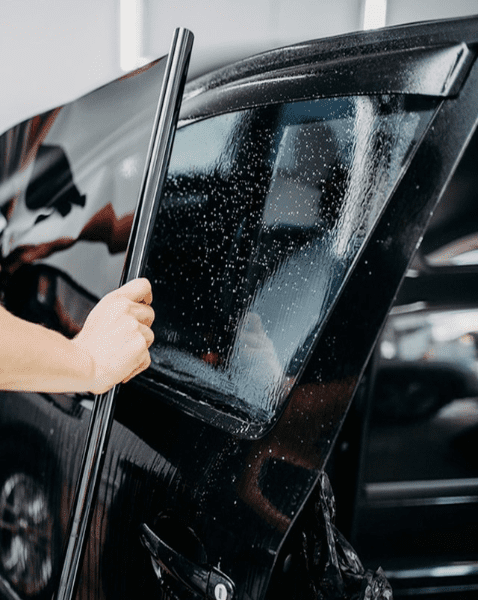Upgrade Your Vehicle’s Look with Moro Auto Spa Window Tinting
Upgrade Your Vehicle’s Look with Moro Auto Spa Window Tinting
Blog Article
Your Comprehensive Guide to DIY Home Window Tinting: Tips and Techniques
Carrying out a DIY window tinting job offers an opportunity to improve both the performance and visual appeals of your area. Before beginning on this undertaking, it is important to navigate the intricacies of neighborhood tinting laws and choose an appropriate movie that straightens with your purposes. From crucial devices to a careful application procedure, each action plays a crucial role in achieving a professional coating. Moro Auto Spa Window Tinting. As you think about the different options and techniques readily available, you might discover on your own wondering about the ideal methods to make sure durability and effectiveness of your color.
Comprehending Home Window Tinting Regulations
Browsing the complex landscape of home window tinting legislations is important for any kind of DIY fanatic seeking to enhance their vehicle's aesthetics and convenience. Each state in the U.S. has certain regulations concerning the allowable levels of color on various home windows, which can considerably influence your decision-making procedure.
Typically, these legislations determine the optimum allowable Visible Light Transmission (VLT) percent, which describes the quantity of light that can pass via the tinted windows. Some states permit only a particular percent of tint on the front windshield, while permitting darker tones on rear windows. Conformity with these laws is critical, as failure to adhere can result in fines or the requirement to get rid of the tint altogether.
In addition, there are frequently differences between passenger lorries and commercial automobiles, with different guidelines putting on each classification. It's recommended to consult your local Department of Electric motor Autos or equivalent authority to gather specific info tailored to your location. Recognizing these legislations not only ensures lawful conformity but also boosts safety by keeping exposure and stopping potential hazards while driving.
Picking the Right Tint Film
Selecting the proper tint movie is a critical action in the DIY window tinting process, as it directly affects both the appearance and capability of your automobile's home windows. Several factors must guide your selection, including the kind of film, its lawful compliance, and your preferred outcomes.
First, take into consideration the different types of color movies available: dyed, metalized, ceramic, and crossbreed. Metalized movies offer boosted heat being rejected and toughness but can interfere with digital signals.
Next, guarantee that the film sticks to neighborhood laws concerning visible light transmission (VLT) portions. Conformity with these regulations is essential to prevent fines and guarantee safety and security.
Essential Tools for DIY Tinting
Having chosen the best tint film for your windows, the next step involves gathering the required tools to make sure an effective installment. The main devices you will need include an utility knife or a razor blade, which is important for cutting the tint film to the desired size. A squeegee is also essential, as it helps eliminate air bubbles and ravel the movie during application.

Moreover, think about making use of a warm gun or hairdryer, as this can aid mold the tint movie to the shapes of the home window and promote adherence. Ultimately, handwear covers are a good idea to avoid fingerprints on the movie during setup. By gathering these crucial devices, you will be well-prepared to tackle your do it yourself window tinting project properly.
Step-by-Step Application Refine
Begin by thoroughly cleansing the home window surface to make certain optimum bond of the color film. Use a glass cleaner and a lint-free towel to remove any kind of dirt, dirt, or grease. Once the home window is clean, gauge the tint film versus the window, enabling a minor overlap on all sides. Cut the film as necessary with a sharp energy knife for a specific fit.
Following, prepare a solution of water and a couple of declines of baby hair shampoo in a spray bottle. Gently spray the window surface area and the sticky side of the film. This solution will certainly permit rearranging during application. Meticulously align the movie with the top of the window, guaranteeing it is right. Press the film against the glass, beginning from the facility and functioning outward to get rid of air bubbles. Use a squeegee to smooth the film, using company, even pressure.
Permit the tint to heal for at least 24 hours without rolling down the home windows. Comply with these steps carefully for optimum click for more results in your DIY home window tinting project.
Upkeep and Care Tips

It's recommended to wait read review at least a week after installation before cleansing your home windows to permit the glue to totally treat. Throughout this preliminary period, stay clear of rolling down the home windows to protect against any damage to the tint.
Regular upkeep entails evaluating the sides of the tint for any signs of gurgling or raising. If you see any type of problems, it's best to resolve them without delay to prevent further wear and tear. Additionally, be mindful with the use of window therapies, such as shades or curtains, as they can generate heat that could endanger the color in time.
Conclusion
In verdict, undertaking a do it yourself window tinting task requires mindful factor to consider of regional regulations, option of proper tint movies, and the utilization of essential devices. An organized application procedure makes sure optimal outcomes, while regular maintenance contributes to the long life of the color - Moro Auto Spa Window Tinting. By adhering to these guidelines, individuals can attain both aesthetic improvement and raised privacy in their rooms, making DIY home window tinting a valuable venture
Report this page